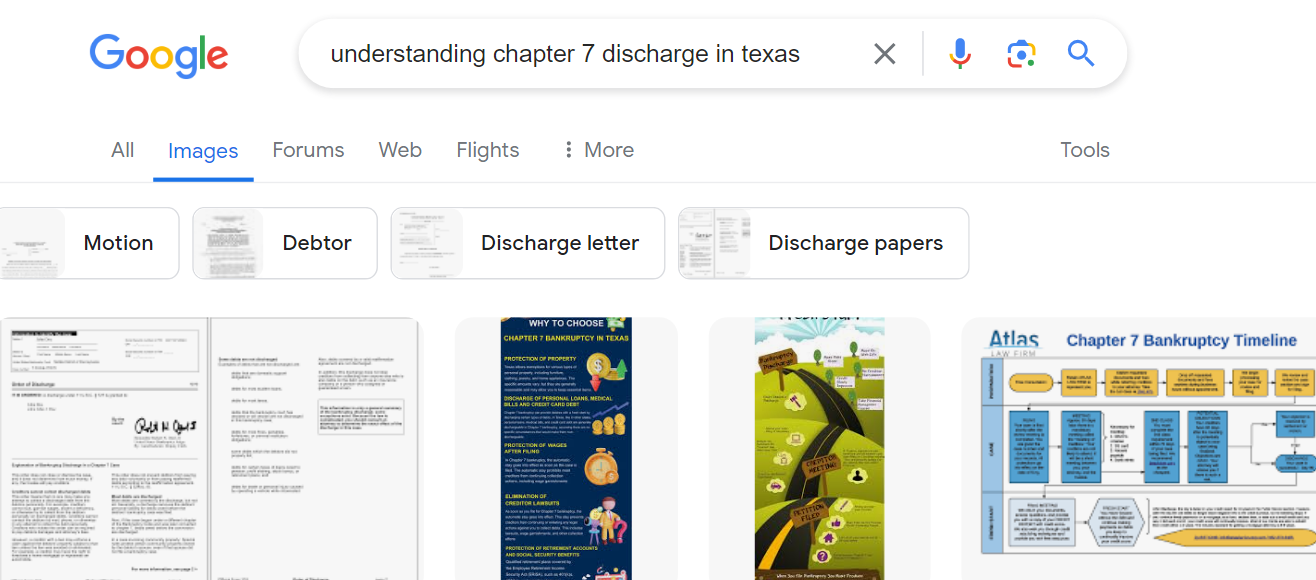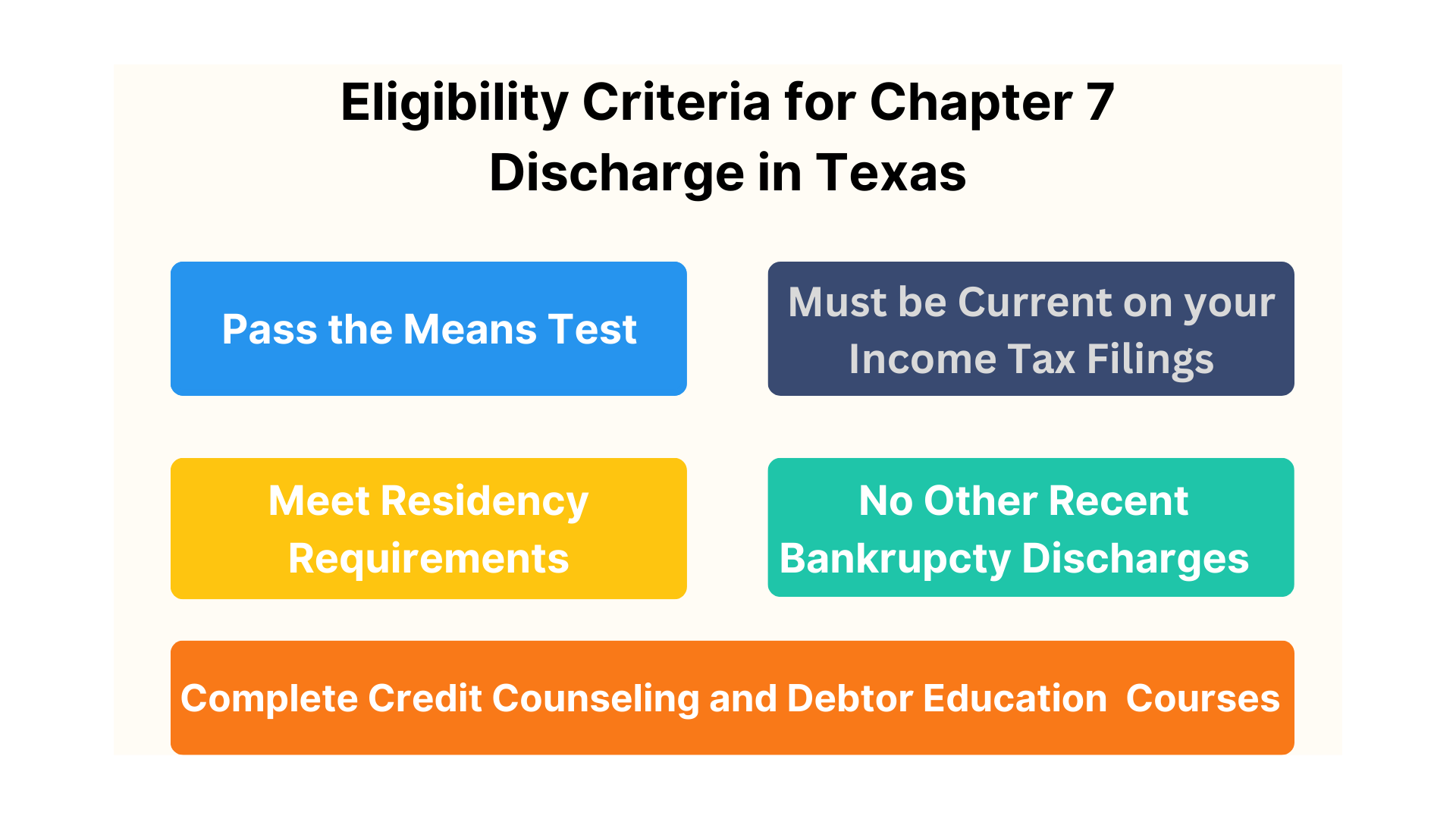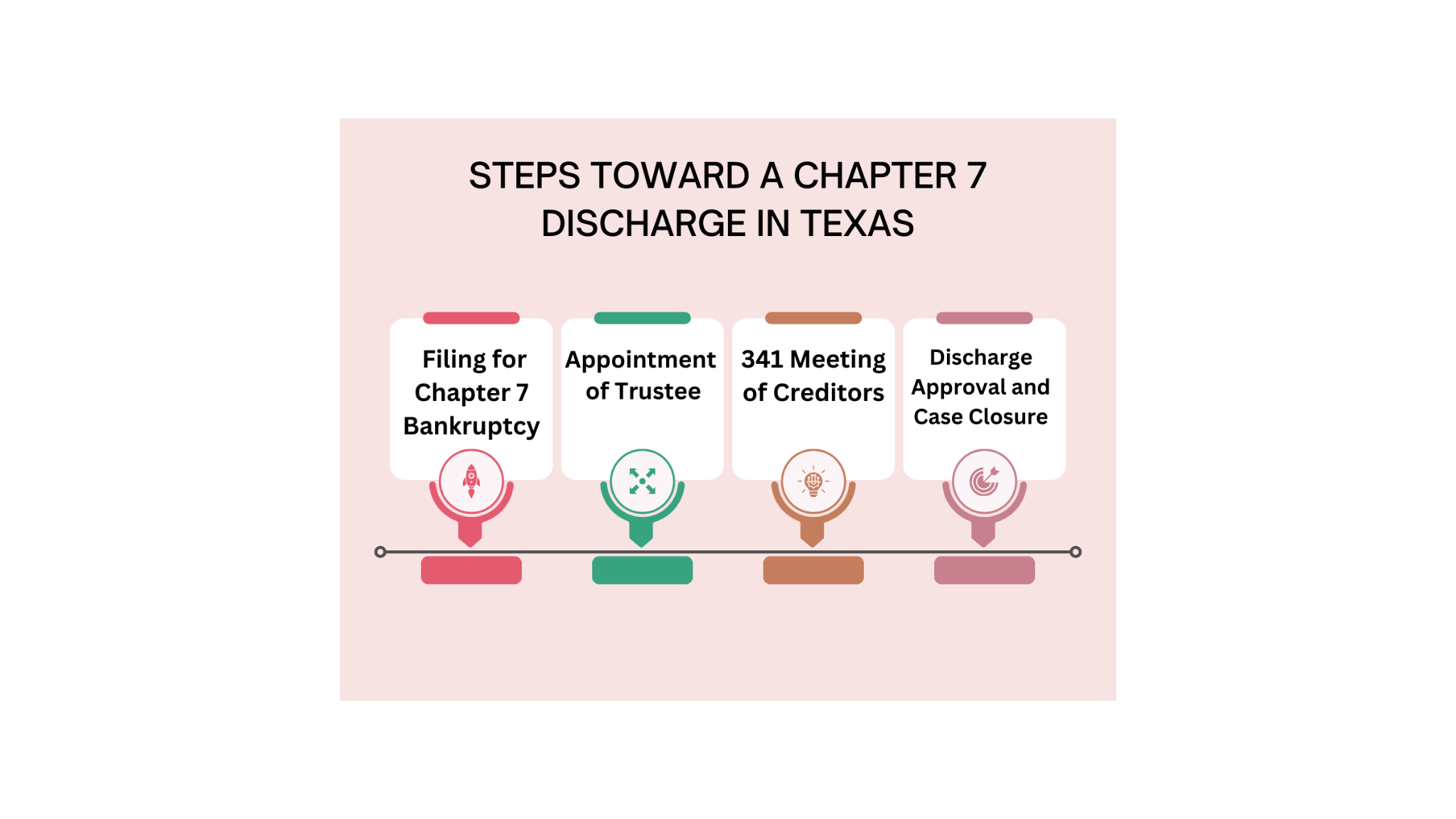As an attorney focusing on bankruptcy law here in Texas, receiving calls from people who are feeling significant financial stress is a common occurrence. Jerry was a hardworking Texan who found himself drowning in debt after a series of unfortunate events. He called me to ask how long a Chapter 7 bankruptcy would take to reach the discharge stage.

“Chris, I don’t know what to do,” Jerry began in a concerned voice. “I hate to admit it, but I’ve been struggling to pay my bills for a while now, and it feels like my creditors are calling me nonstop. I’ve heard about people filing for bankruptcy, but I have no interest in getting sucked into a long, drawn-out legal process. I don’t need the extra stress. If I file for bankruptcy, how long will it take until I can get these creditors off my back?”
I reassured Jerry that his concerns were valid and that many people in Texas face similar situations. Then I explained that a Chapter 7 bankruptcy proceeding in Texas takes an average of four to six months from start to finish.
“I know four to six months sounds like a long time, but it’s relatively short compared to your other options,” I told him. “Plus it breaks down into a series of shorter steps so if we think about it one step at a time, it’ll feel even faster. Please let me explain the timeline and the process in some detail for you.”
For those of you like Jerry, thinking about filing for Chapter 7 bankruptcy in Texas, one question usually comes to mind: how long will it take until you can feel financial freedom? The sought-after outcome after filing for bankruptcy is securing a Chapter 7 discharge of your debts. An accurate understanding of the requirements and the timeline will help you plot your course through the sometimes complex world of bankruptcy more effectively.
Bankruptcy, like many life processes, is fraught with uncertainty. Chapter 7 proceedings are no exception. Between eligibility criteria, trustee vigilance, and state-specific demands, multiple moving parts converge to shape the timeline of your discharge. Please join us as we explore the web of regulations surrounding Chapter 7 bankruptcy in Texas and set your sights on a successful discharge.
Understanding Chapter 7 Bankruptcy Discharge in Texas

If you’re considering filing for Chapter 7 bankruptcy in Texas, it’s important to understand how the discharge process works. A bankruptcy discharge is the ultimate goal of filing for bankruptcy. It’s the court order that releases you from personal liability for certain types of debts, giving you a fresh financial start.
Chapter 7 bankruptcy cases usually receive a discharge about four to six months from the date you file, provided there are no objections or issues that arise from creditors. This marked approval permanently prevents creditors from trying to collect on discharged debts, including unpaid credit card balances, medical bills, and personal loans.
However, not all debts can be discharged in a Chapter 7 bankruptcy. Some debts, such as most student loans, child support, and certain taxes, are generally not dischargeable. Additionally, if you have nonexempt property that the bankruptcy trustee can sell to pay creditors, this may impact your bankruptcy case and discharge.
Eligibility Criteria for Chapter 7 Discharge in Texas
To be eligible for a Chapter 7 discharge in Texas, you must meet certain criteria. One of the most important eligibility requirements is passing the means test.
Means Test for Chapter 7 Eligibility
In determining whether you’re eligible for Chapter 7 bankruptcy, the means test examines your income, expenses, and family size to assess whether you have enough disposable income to make some debt payments. If your income falls below the median for your household size in Texas, you automatically qualify for debt relief. But even if your income exceeds the median, you may still be eligible based on your expenses and debt payments.
To see if you pass the means test, you can use a Chapter 7 means test calculator. If you don’t pass the means test, you may need to consider filing for Chapter 13 bankruptcy instead, which involves a three to five year payment plan.
Other Eligibility Requirements for Chapter 7 Discharge in Texas
Individuals must meet additional eligibility requirements beyond just passing the means test to apply for a Chapter 7 discharge in Texas.
- You must complete a credit counseling course from an approved provider within 180 days before filing bankruptcy.
- You cannot have received a Chapter 7 discharge in the past 8 years or a Chapter 13 discharge in the past 6 years.
- You must be current on your income tax filings.
- You must complete a debtor education course after filing bankruptcy to receive your discharge.

Meeting residency requirements is equally important when filing for bankruptcy in Texas. You need to have either lived in the state for 91 of the last 180 days or have a major stake in Texas for that duration. Meeting this requirement is essential for obtaining a Chapter 7 discharge and resolving financial crunches.
Timeline for Chapter 7 Discharge in Texas
If you’re wondering when the court will discharge your Chapter 7 case in Texas, the timeline typically ranges from four to six months after you file your bankruptcy paperwork. Here’s a general overview of the Chapter 7 bankruptcy timeline in Texas:
Filing Chapter 7 Bankruptcy in Texas
The Chapter 7 process begins when you file your bankruptcy petition and schedule with the bankruptcy court. In Texas, you’ll file in the district where you live or have your domicile. When you file, you’ll also pay a $338 filing fee unless you qualify for a fee waiver based on your income.
Fully revealing your financial situation is crucial when filing for bankruptcy. This includes outlining your income, expenses, debts, and assets. Remember to account for any exempt property under Texas or federal exemptions. Accurate and complete bankruptcy forms are the keys to avoiding potential complications with your case.
Meeting of Creditors and Trustee Review
About a month after you file your Chapter 7 bankruptcy case, you’ll attend what’s called a 341 meeting of creditors. This is typically a short hearing where the bankruptcy trustee and any creditors can ask you questions about your bankruptcy case and your finances.
As the trustee delves into your bankruptcy case, they’ll review your paperwork, investigate any potential wrongdoing, and transform your nonexempt assets into cash to pay off your debts. The fate of your property hangs in the balance: if it’s not exempt, the trustee may very well seize and liquidate it, using the proceeds to satisfy creditor claims. The trustee will also verify that you meet the requirements for a Chapter 7 discharge.
Discharge Approval and Case Closure
If there are no objections or complications in your case, the bankruptcy court will typically grant your Chapter 7 discharge within 60-90 days after your 341 meeting. Once your discharge is entered, your case is usually closed shortly after that, unless there are pending motions or adversary proceedings.

If you have nonexempt assets that the trustee is administering, your case may remain open longer until those assets are fully administered and the trustee submits a final report to the court. But in most Chapter 7 cases, you’ll receive your discharge and case closure within about four to six months from the date you file bankruptcy. This timeline can vary depending on the complexity of your case and any bankruptcy issues that arise.
Role of the Trustee in Chapter 7 Discharge in Texas
When you file for Chapter 7 bankruptcy in Texas, a trustee is assigned to oversee your case. The trustee is an impartial administrator who is responsible for ensuring that your bankruptcy case follows the law. The trustee is not on your side or the creditors’ side.
To start the bankruptcy process, the trustee takes a close look at your paperwork and supporting documents to uncover any potential issues. By cross-checking your reported income with your actual income and scrutinizing your expenses, they get a clear picture of your financial situation.
The trustee also has the power to investigate your financial affairs and transactions in the months and years before you filed bankruptcy. They can investigate any fraudulent transfers or preferential payments to creditors that might be recovered into the bankruptcy estate. This ensures all assets are properly disclosed and accounted for in your case.
If you have any nonexempt property, the trustee’s role is to liquidate those assets and distribute the proceeds to your creditors. Nonexempt property is anything that is not protected by Texas or federal exemptions, such as valuable collections, investments, or expensive cars or jewelry. The trustee will determine which assets are nonexempt and take possession of them for liquidation.
You’ll soon face the 341 meeting of creditors, where the trustee will ask you questions about your finances and bankruptcy paperwork. Honesty is key here. Answer honestly and be transparent about your financial situation to avoid any issues with your discharge.
Texas-Specific Requirements for Chapter 7 Discharge
Although federal law governs much of the Chapter 7 bankruptcy process, specific Texas requirements and considerations can affect your case and discharge.

Texas Exemptions and Asset Protection
Exemptions determine what property you can keep safe from liquidation by the trustee. Texas has some of the most generous exemptions in the country, especially when it comes to your homestead. In Texas, your homestead is fully exempt, regardless of value, as long as it meets the acreage limits (10 acres urban, 100 acres rural families, 200 acres rural singles/families). This means that you can protect your home from being sold to pay creditors in bankruptcy.
Behind the rugged image of Texas lies a softer side, one of tangible exemptions shielding personal property. Embracing the freedom that comes with these various exemptions can be a rewarding step for any individual or homeowner.
Up to $50,000 in personal property for individuals, $100,000 for families.
One vehicle per licensed household member.
Certain retirement accounts and insurance benefits.
Current wages for most workers.
Lucky for those overwhelmed with financial woes, specific bankruptcy laws grant eligible petitioners select assets protection. By closely reviewing and claiming available exemptions from the courts, Texans can retain financial anchors and maintain a stable life regardless of financial instability.
Impact of Texas Laws on Discharge Timeline
In addition to exemptions, some Texas laws and requirements can impact the timeline for getting your Chapter 7 discharge.
Filing for bankruptcy in Texas requires a financial education. This is where credit counseling courses come into play. These courses provide valuable insights into your financial situation and guide you away from potential pitfalls that might hinder your discharge. Remember, it is essential to cooperate with authorized providers and round off your coursework to expedite your transition to debt relief.
Texas also has a state-specific means test, which has slightly different income limits and expense calculations than the federal means test. If you are close to passing the means test, you may want to consider working with a local bankruptcy lawyer who is familiar with the nuances of the Texas means test. They can help you determine your eligibility and explore whether filing Chapter 7 or Chapter 13 bankruptcy is in your best interest.
Procedures for Chapter 7 Discharge Approval in Texas

However, there are some situations where your discharge may be delayed or denied. For example, if a creditor, the trustee, or the U.S. Trustee’s office files an objection to your discharge, you may have to go to court to resolve the objection. Objections to discharge are rare but can happen if there are allegations of fraud, concealment of assets, or other misconduct. It’s important to take any objections seriously and seek legal counsel if necessary.
If you are not eligible for a Chapter 7 discharge due to a prior bankruptcy filing or other reasons, the court may dismiss your case without a discharge. In that situation, you may be able to convert to a Chapter 13 case and seek a discharge through a repayment plan instead. A local bankruptcy lawyer can help you understand your options and choose the best path forward given your specific financial situation.
When seeking a Chapter 7 discharge in Texas, upfront honesty, transparency, and cooperation are crucial for a successful outcome. Avoid stress and uncertainty by partnering with a seasoned Texas bankruptcy attorney who can expertly navigate the often-complex process.
Key Takeaway:
To get your Chapter 7 bankruptcy discharge in Texas, focus on accuracy and honesty when filing your paperwork, complete all required courses, and cooperate with the trustee to ensure a smooth process and receive your discharge within four to six months.
FAQs in Relation to When Will Chapter 7 Be Discharged
How long does Chapter 7 take to discharge?
The timeline for a Chapter 7 discharge typically ranges from four to six months from the filing date. Think of it like running a marathon – it takes dedication and perseverance, but with the right guidance, you’ll cross the finish line in no time.
What percent of Chapter 7 bankruptcies are dismissed?
Only a small percentage of Chapter 7 bankruptcies, about 10-15%, are ultimately dismissed. Avoid being one of the dismissed cases by seeking help from a qualified bankruptcy lawyer who can guide you through the process.
Can Chapter 7 be removed early?
Typically, Chapter 7 cases are not dismissed early, as the trustee needs time to review and liquidate nonexempt assets. It takes time for the trustee to do their job, ensuring a smooth and successful discharge.
How often do creditors object to discharge?
Creditors rarely object to discharge, as they often focus on receiving payment through the trustee. In most cases, creditors prioritize collecting what they can from the liquidation of nonexempt assets rather than contesting the discharge.

Conclusion
Obtaining a Chapter 7 discharge in Texas can be a life-changing event. It provides much-needed relief from overwhelming debt and a fresh financial start. But the process isn’t always straightforward. Understanding the timeline of your Chapter 7 discharge is key to navigating the bankruptcy journey successfully.
Vital to a successful bankruptcy filing is understanding the eligibility criteria, timeline, and Texas-specific requirements. By being aware of these crucial factors, you’ll be better equipped to prepare for the road ahead and lay the groundwork for a timely discharge. Collaborating with a knowledgeable bankruptcy attorney can be the key to a seamless process and achieving the maximum benefits of a Chapter 7 discharge.
Embarking on the path to financial freedom through a Chapter 7 bankruptcy proceeding takes courage and commitment, but with the right knowledge and support, you can emerge from the process with a brighter, more stable financial future. So take heart, stay focused, and keep your eye on the prize: that all-important Chapter 7 discharge that will mark the beginning of your new financial life.
For more information, visit our website. You’ll find great resources there. If you are ready to start the process or talk to an attorney, call our law office now at (888) 584-9614 or contact us online to schedule a consultation.
How Did the Four to Six Month Timeline Impact Jerry?
As Jerry processed this information I could see the relief on his face. Knowing that the entire process could be completed in about four to six months was a huge comfort to him. In fact, it was a pleasant surprise.
He said, “I was sure you’d say it would take at least a year, maybe longer. When my cousin back in New York admitted to me he was going through bankruptcy, he made it seem like it was taking years. Four to six months, I can handle that.”

“Remember Jerry, that’s the average, but stuff can happen. I’m not sure what happened with your cousin in New York but if we follow protocol here in Texas, yes, that four to six month range is generally accurate,” I told him.
“Then let’s do it. How do we file?” he said.
“Jerry, you’ve got a lot of information to get to me so I can evaluate your entire set of circumstances and prepare your case,” I told him. “I know the time frame is what you are focused on but it’s just one component of all the work we have to do. But if you do your homework, and get it to me within a week, I’d hope to be able to begin the formal filing process by the end of the month. Remember, the timeline only works well, if we work well as a team. That means you’ve got to do your part. Got it?”
“Sure do. So what’s my homework?” he asked.
Glad you asked. I proceeded to explain all the documentation regarding his assets, debts, income, and expenses he would need to compile. Jerry didn’t like having homework but assured me he would get it done in a timely manner. We decided to move the Chapter 7 bankruptcy process forward ASAP and five months later most of his debts were discharged.
Schedule a Consultation with our Dallas Firm to Learn How Long It Takes From When You File for Chapter 7 Bankruptcy to Discharge
Debt collection lawsuits can be stressful and challenging, but you do not have to face it alone. Our team of experienced Dallas debt defense attorneys is ready to provide you with the guidance, support, and legal advocacy you need during these challenging times.
Whether you are trying to learn about the Chapter 7 timeline or navigating other debt collection issues, we are here to help you every step of the way. We welcome you to schedule a consultation to discuss your situation and case objectives. We can answer your legal questions and discuss how we can help you move forward. Call our law office at (888) 584-9614 or contact us online to schedule your consultation.

